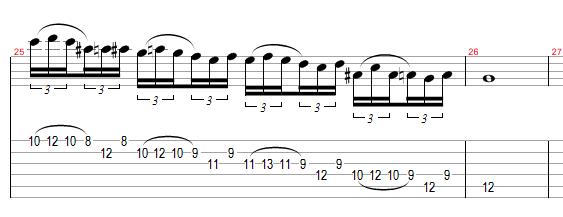By: Shai Agmon

Shai Agmon
This guitar lesson is about the Lydian dominant scale that is a very common scale used in jazz and fusion music, and has a very unique, easy to recognize character, which characterizes a lot of fusion players, such as Allan Holdsworth and Frank Gambale.
The scale is actually a mode of the harmonic minor scale, and is a combination of the Lydian mode, and the Dominant mode:
Lydian mode is a major scale with a #4
Dominant mode is a major scale with a b7
So, the Lydian dominant scale/mode is actually a major scale with both #4 and b7 which makes its structure: 1,2,3,#4,5,6,b7. For example, in the key of C the scale would be : C,D,E,F#,G,A,Bb
The first example is audio-only and is of a short improvisation I did using C Lydian dominant and Eb Lydian dominant scales
You can immediately recognize its dark and mysterious sound that is heard a lot in fusion. However, it is also used a lot in different contexts in many musical genres: from bebop and classical jazz to flamenco, modal jazz and progressive rock/metal.
The Lydian dominant works on chords which has either b7, #11 (#4) , or both. In this example I am showing the chord progression I have used for the first example: the chords are C7#11 and E7#11, and I am also adding the 13 from time to time.
Notice that my guitar is tuned to drop C, so in case you’re on standard tuning move everything two frets down, and the 6th string 4four frets down- it will actually be easier for you to play that way :

The next example #3, is a C Lydian dominant scalar passage (looks like D in the tabs, but that’s because I’m tuned a whole step lower) that immediately spices up the solo with some odd, dark fusion sound. It can also work great on regular major chords that function as Lydian in the current chord progression, as long as it doesn’t have the maj7 or flat 11 in it:
Notice that in the last beat I also used the b9 (C#) once, to give a taste of the dim scale sound. The Diminished scale has some similarities to the Lydian dominant (because the Lydian dominant also contains a tetra chord of Half step-Whole step-Half step, which doesn’t exist in diatonic scales), so they might be combined in a lot of situations.

EXAMPLE #3

Okay, the next example (Example #4) is a combination of alternate picking and legato, with a more pattern like sound that can work great with distortion. This type of lick is highly used by progressive rock and metal bands, and usually might be used as a bridge or a part of an instrumental section in a song.

EXAMPLE #4

This final example (Example #5) is a set of very easy to play (relatively) legato triplets, which makes a simple sequence in the Lydian dominant scale. In the video example, I played it in two scales: C and Eb, with the chords C7#11 and Eb7#11, respectively.

EXAMPLE #5

Hope this was useful; feel free to approach me if you have any questions or interest in additional information! And check out my new FB artist page for updates HERE!
About Shai Agmon: Shai Agmon is a guitarist, pianist and composer from Israel, performing with local rock and folk musicians. He is currently working on his first solo album, planned to be released in 2014. His music is very eclectic and combines influences from rock, latin, Flamenco, orchestral and modal jazz music. Initial recordings and sketches can be heard HERE.